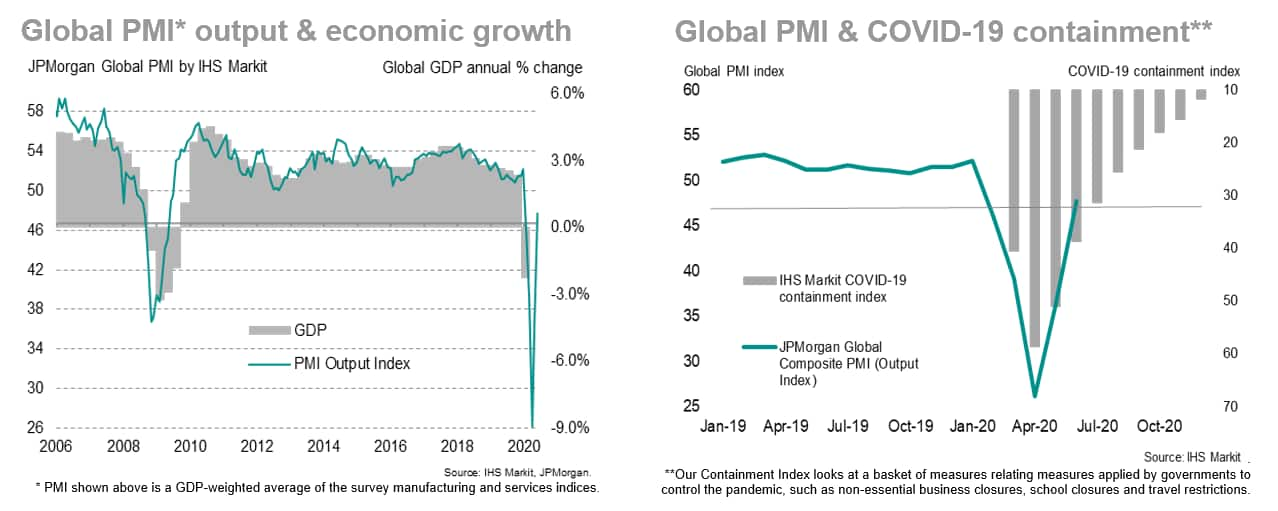Customer Logins
Obtain the data you need to make the most informed decisions by accessing our extensive portfolio of information, analytics, and expertise. Sign in to the product or service center of your choice.
Customer Logins
BLOG
Jul 13, 2020
Global economic recovery gains momentum in June, but job market casts cloud on outlook
The following is an extract from IHS Markit's monthly PMI overview presentation. For the full report please click on the link at the bottom of the article.
The JPMorgan Global PMI™ (compiled by IHS Markit) jumped by a record 11.4 index points in June, building on a prior record increase of just over 10 index points in May to push the index to a five-month high. Despite the rise, at 47.7, the PMI remained below the no-change 50.0 level to indicate a fifth successive monthly deterioration of output across the combined manufacturing and service sectors. However, historical comparisons indicate that a PMI reading of 46.7 is the cut off level between global GDP rising or falling on an annual basis, suggesting that the June surveys were indicative of a very modest return to growth for the global economy.
The rebound in the PMI from it's unprecedented low in April has been driven by the loosening of COVID-19 containment measures around the world during both May and June, which has resulted in many non-essential businesses reopening and demand picking up again, albeit from a low base in most cases.

Chris Williamson, Chief Business Economist, IHS
Markit
Tel: +44 207 260 2329
chris.williamson@ihsmarkit.com
© 2020, IHS Markit Inc. All rights reserved. Reproduction in whole or in part without permission is prohibited.
Purchasing Managers' Index™ (PMI™) data are compiled by IHS Markit for more than 40 economies worldwide. The monthly data are derived from surveys of senior executives at private sector companies, and are available only via subscription. The PMI dataset features a headline number, which indicates the overall health of an economy, and sub-indices, which provide insights into other key economic drivers such as GDP, inflation, exports, capacity utilization, employment and inventories. The PMI data are used by financial and corporate professionals to better understand where economies and markets are headed, and to uncover opportunities.
This article was published by S&P Global Market Intelligence and not by S&P Global Ratings, which is a separately managed division of S&P Global.
{"items" : [
{"name":"share","enabled":true,"desc":"<strong>Share</strong>","mobdesc":"Share","options":[ {"name":"facebook","url":"https://www.facebook.com/sharer.php?u=http%3a%2f%2fwww.spglobal.com%2fmarketintelligence%2fen%2fmi%2fresearch-analysis%2fglobal-economic-recovery-gains-momentum-in-june-June20.html","enabled":true},{"name":"twitter","url":"https://twitter.com/intent/tweet?url=http%3a%2f%2fwww.spglobal.com%2fmarketintelligence%2fen%2fmi%2fresearch-analysis%2fglobal-economic-recovery-gains-momentum-in-june-June20.html&text=Global+economic+recovery+gains+momentum+in+June+but+job+market+casts+cloud+on+outlook+%7c+S%26P+Global+","enabled":true},{"name":"linkedin","url":"https://www.linkedin.com/sharing/share-offsite/?url=http%3a%2f%2fwww.spglobal.com%2fmarketintelligence%2fen%2fmi%2fresearch-analysis%2fglobal-economic-recovery-gains-momentum-in-june-June20.html","enabled":true},{"name":"email","url":"?subject=Global economic recovery gains momentum in June but job market casts cloud on outlook | S&P Global &body=http%3a%2f%2fwww.spglobal.com%2fmarketintelligence%2fen%2fmi%2fresearch-analysis%2fglobal-economic-recovery-gains-momentum-in-june-June20.html","enabled":true},{"name":"whatsapp","url":"https://api.whatsapp.com/send?text=Global+economic+recovery+gains+momentum+in+June+but+job+market+casts+cloud+on+outlook+%7c+S%26P+Global+ http%3a%2f%2fwww.spglobal.com%2fmarketintelligence%2fen%2fmi%2fresearch-analysis%2fglobal-economic-recovery-gains-momentum-in-june-June20.html","enabled":true}]}, {"name":"rtt","enabled":true,"mobdesc":"Top"}
]}




